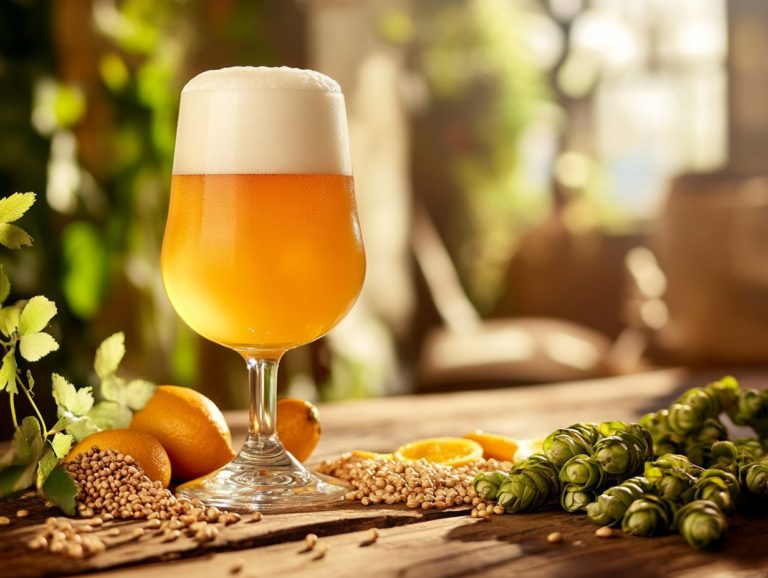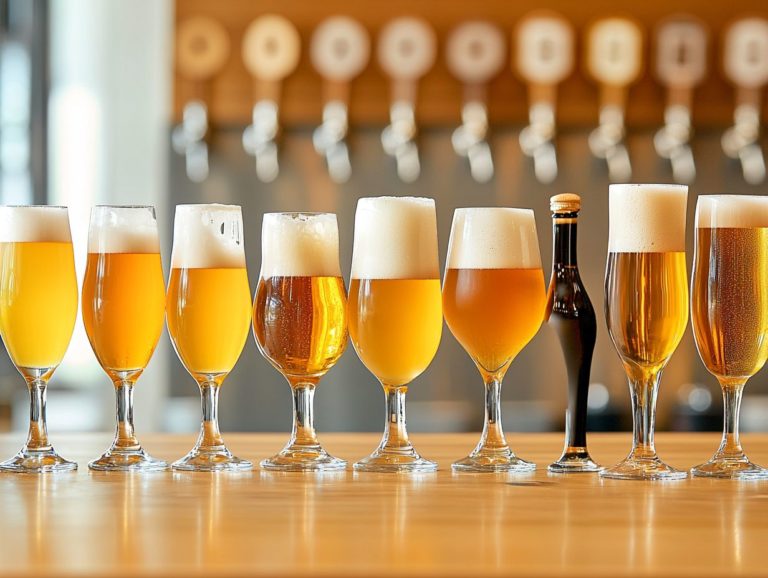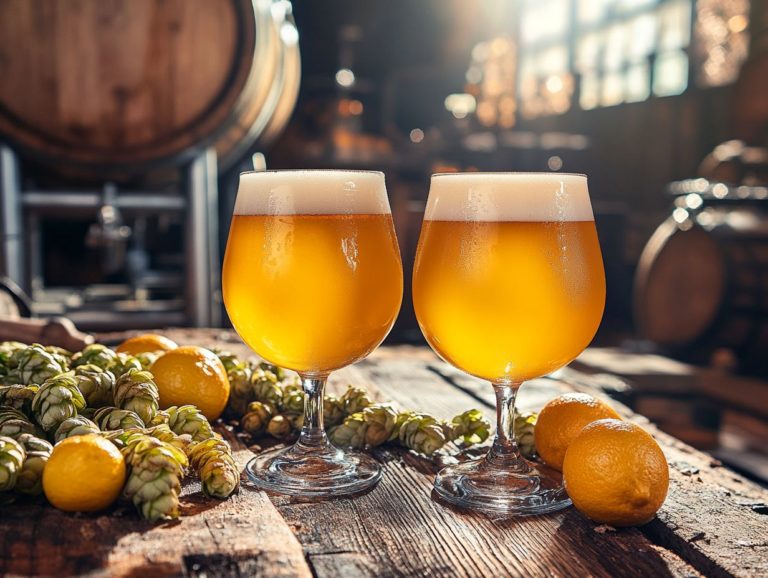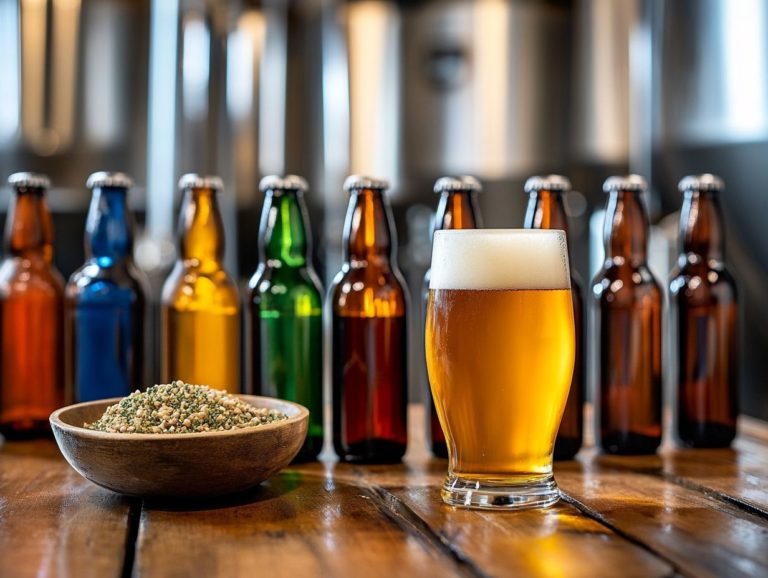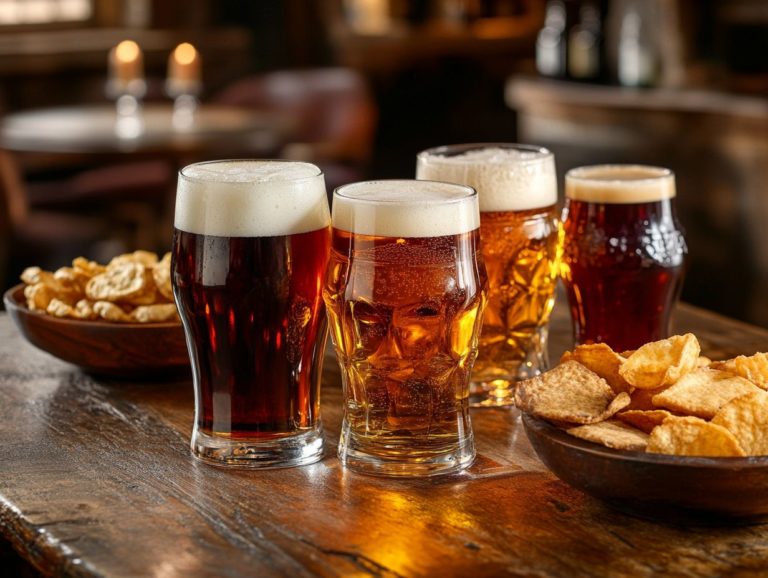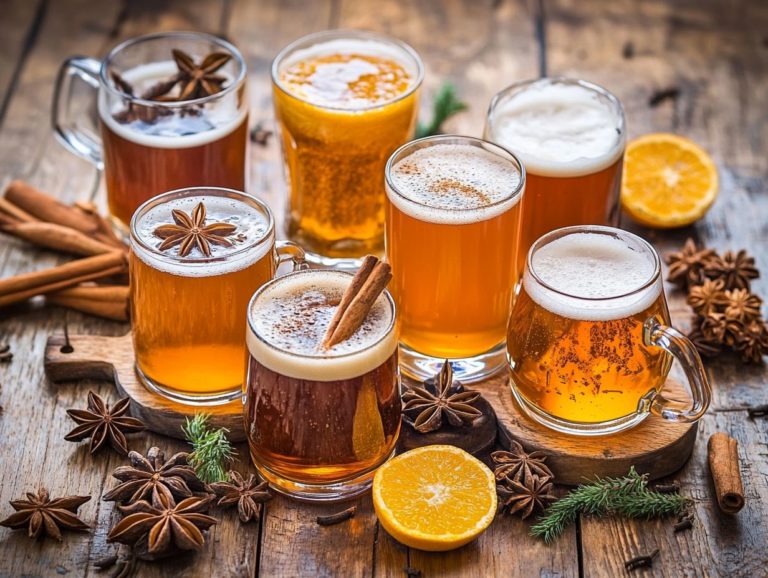5 Craft Beer Styles with Unique Ingredients
Craft beer enthusiasts like you are always in search of innovative flavors and unique brewing techniques that elevate your favorite brews to new heights.
This article takes you on a journey through five exciting craft beer styles that seamlessly blend traditional brewing techniques with unique ingredients. From the vibrant fruity bursts of fruit-infused beers to the intricate profiles of spiced and sour varieties, each style promises a unique tasting experience tailored for your palate.
You ll also delve into the fascinating world of barrel-aged and smoked beers, discovering the special qualities that set them apart. Join in the celebration of the creativity and craftsmanship behind these exceptional brews, and let your appreciation for craft beer flourish.
Contents
- Key Takeaways:
- 1. Fruit-Infused Beers
- 2. Spiced Beers
- 3. Sour Beers
- 4. Barrel-Aged Beers
- 5. Introduction to Smoked Beers
- What Makes Smoked Beers Unique?
- How Are Smoked Beers Made and What Gives Them Their Distinct Flavor?
- Frequently Asked Questions
- What are the top 5 craft beer styles with unique ingredients?
- What makes Belgian Witbier a unique craft beer style?
- What makes German Rauchbier stand out from other craft beer styles?
- Why is American IPA considered a craft beer with unique ingredients?
- What sets Scottish Ale apart from other craft beer styles?
- Why is Mexican-style Lager a must-try for craft beer enthusiasts?
- Frequently Asked Questions
Key Takeaways:
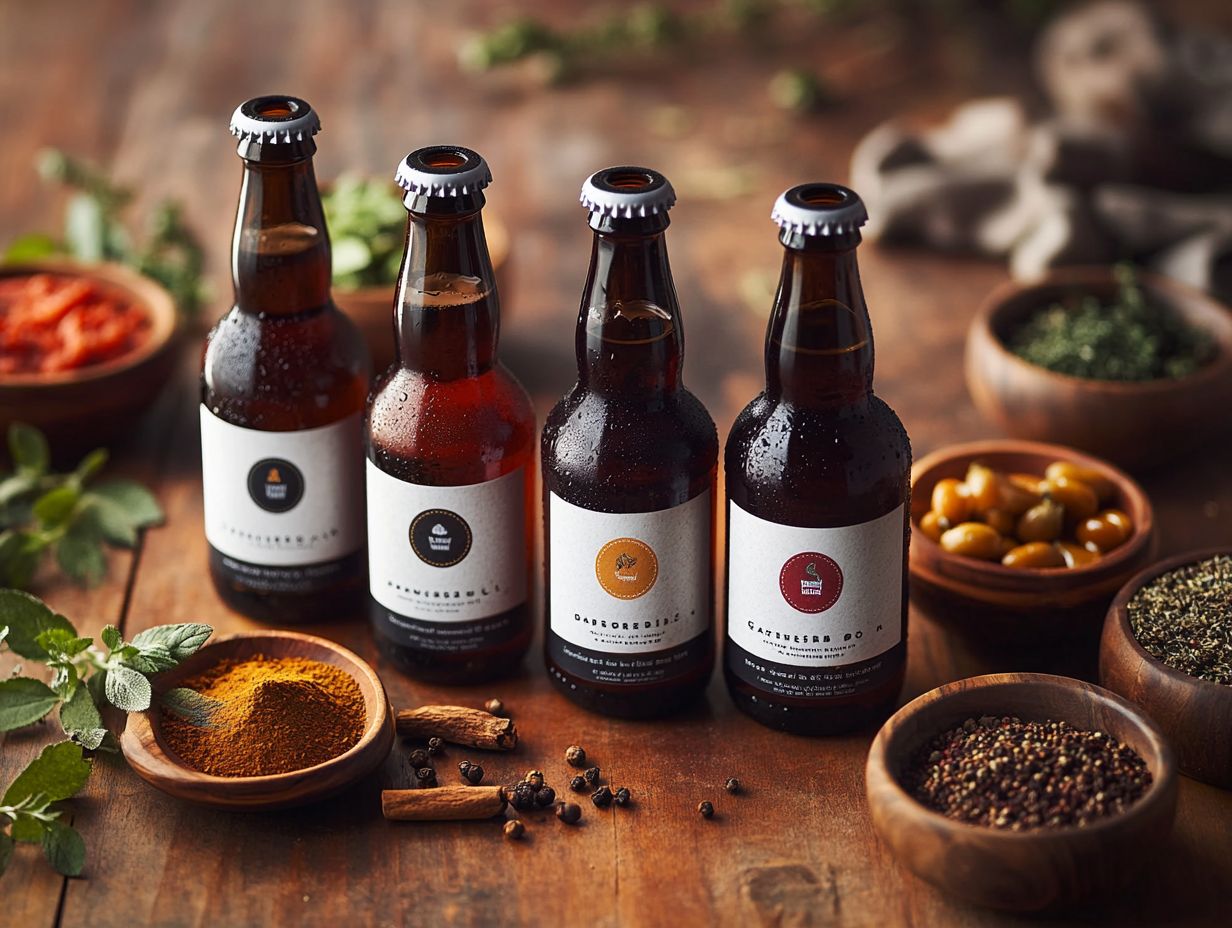
- Fruit-infused beers offer a unique twist on traditional beers by incorporating fresh fruits such as berries and pumpkins during the brewing process, resulting in a refreshing and fruity flavor profile.
- Spiced beers utilize a variety of herbs, spices, and botanicals to create complex and flavorful brews, making them a perfect choice for those looking for a unique tasting experience.
- Sour beers stand out for their tart and acidic taste, achieved through the use of special yeast strains and bacteria during the fermentation process, making them a popular choice among beer enthusiasts.
1. Fruit-Infused Beers
Fruit-infused beers embody a fascinating blend of creativity and brewing traditions, where craft breweries like Rogue Ales and Wynkoop Brewing Company expertly harness the natural sweetness and complexity of fruits like berries, pumpkins, and even peppers. This thoughtful incorporation during the brewing process gives rise to unique flavor profiles that truly delight the senses.
By adding ingredients such as orange peel and employing innovative fermentation techniques, these breweries enhance the overall sensory experience while catering to your evolving preferences for refreshing and diverse beer options. The cultural significance of these brews is deeply rooted in history, emphasizing the vital role that flavor diversity plays in the craft beer landscape.
You ll find this trend reflected in many craft breweries that emphasize local sourcing, often integrating seasonal fruits from nearby farms to craft limited-edition brews that celebrate regional flavors. For instance, the use of tart cherries in a beer can beautifully echo a brewery’s heritage, creating a tangible connection between you, the drinker, and the land’s culinary bounty.
Notable establishments like New Belgium Brewing and Dogfish Head have gained acclaim for their adventurous approaches, experimenting with techniques such as barrel aging with fruit to achieve complex, layered tastes. As you increasingly seek products that tell a story, fruit-infused beers not only cater to your palate but also fulfill your desire for authentic, culturally resonant experiences.
2. Spiced Beers
Spiced beers have carved out a captivating niche within the craft beer movement. Brewers creatively experiment with a delightful range of herbs and spices, such as coriander, lavender, and chamomile. Each brewery uses innovative methods to craft a unique sensory experience, showcasing the boundless creativity that defines the art of brewing.
With their alluring aromas and distinctive flavors, these spiced beers tantalize your taste buds and invite you to explore the rich cultural traditions and historical examples that inspire their recipes.
Imagine how these spices can elevate a traditional lager or ale, layering flavors that turn every sip into an adventurous journey. Some craft brewers sprinkle in cinnamon and nutmeg to evoke the cozy warmth of fall, while others daringly incorporate exotic spices like cardamom or anise to create intriguing seasonal offerings. Breweries like Bruggh s Ste ja and Mikkeller are known for their innovative use of spices that lead to unique beer experiences.
Consider the artistry of notable craft breweries like Dogfish Head Brewery, with their ‘Chicory Stout’ featuring roasted chicory and coffee. 3 Floyds Brewing s ‘Gumballhead’ tantalizingly hints at citrusy notes from Amarillo hops. Another great example is the Pizza Beer Company, known for their unique spice blends. These breweries reflect the innovative use of spices in brewing while enriching your beer experience and paying tribute to the diverse culinary histories intertwined with these remarkable ingredients.
3. Sour Beers
Sour beers embody a fascinating evolution in the brewing world. Innovative techniques and unique ingredients converge to create a complex tapestry of flavors that will truly tantalize your taste buds. By harnessing wild yeast and specific bacteria like Lactobacillus, Pediococcus, and Brettanomyces, craft breweries achieve a distinct sourness. This transforms traditional brewing methods into a creative exploration of fermentation. This journey into sour beers illuminates the technical artistry of brewing and reflects your growing preference for adventurous and unconventional flavor experiences.
The rise of sour beers has introduced a variety of styles, including Berliner Weisse, Gose, and Flanders Red. Each style showcases a different fermentation approach that contributes unique characteristics to the final product. As craft breweries continue experimenting with barrel aging and fruit additions, they elevate the complexity of these brews to cater to your desire for innovative tastes.
Your demand for diverse options has inspired established breweries to push their creative boundaries and opened doors for new players in the market. This firmly establishes sour beers as a prominent fixture in the modern beer landscape.
4. Barrel-Aged Beers
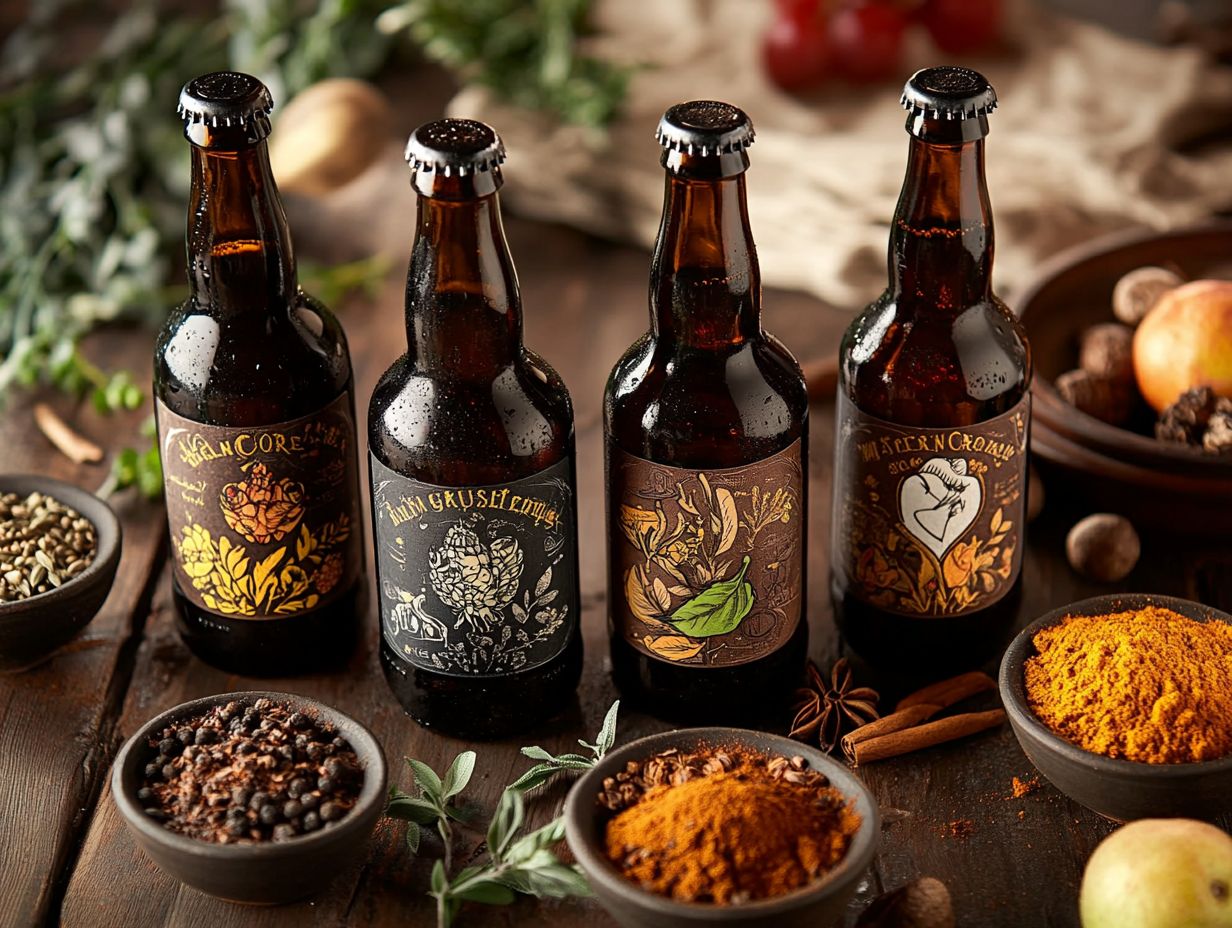
Barrel-aged beers have emerged as a standout in the craft brewing world. Known for their distinctive aging process, they weave intricate flavors and aromas into each pour. By employing a variety of barrels such as whiskey, wine, or rum craft breweries harness a treasure trove of innovative tastes, enriching their brews with complex profiles that echo the characteristics of the aging vessel.
This multifaceted approach showcases the brewers’ creativity and satisfies your growing appetite for unique and high-quality beer experiences.
Each barrel type adds its own signature notes. For instance, whiskey barrels often impart rich caramel and vanilla undertones, while red wine barrels contribute delightful hints of fruitiness and tannins. Additionally, some breweries use pasteurizers to preserve these intricate flavors over time.
Breweries like Firestone Walker and Fremont Brewing have garnered acclaim for their barrel-aging programs. They employ techniques like blending and secondary fermentations to enhance flavor depth. By experimenting with aging durations and barrel combinations, these craft brewers consistently push the envelope of flavor, crafting beers that stand out and invite your palate on a journey through a spectrum of tastes and aromas with every sip.
Explore these exciting beer styles and visit your local craft breweries to experience the creativity and uniqueness of spiced, sour, and barrel-aged beers!
5. Introduction to Smoked Beers
Smoked beers provide a remarkable drinking experience, defined by the use of unique ingredients that impart a rich, smoky flavor to the brew. This process draws heavily from traditional methods of smoking grains like barley. Craft breweries are boldly pushing the boundaries of creativity, experimenting with various smoking techniques and wood types to produce innovative flavors that truly captivate the senses.
This exploration of smoked beers not only highlights the versatility of the brewing process but also emphasizes the sensory experiences that craft beer enthusiasts crave. To craft these exceptional beverages, brewers create them with cherrywood, hickory, or peat. These ingredients add layers of complexity and distinctive flavor profiles. Classics like Rauchbier from Bamberg, Germany, deliver a flavor that reminds you of bacon, while contemporary interpretations, such as Stone Brewing’s ‘Smoked Porter’, blend rich chocolate and caramel notes with a subtle smoky backbone.
These enticing flavor profiles cater to a diverse range of palates, appealing to those adventurous enough to seek bold tastes as well as those who appreciate a more nuanced sipping experience.
What Makes Smoked Beers Unique?
The uniqueness of these diverse beer styles arises from an intricate blend of innovative brewing techniques, distinctive ingredients, and the cultural significance each style embodies, showcasing the artistry and creativity of craft breweries. As you seek out exceptional sensory experiences, the craft beer industry has eagerly responded, embracing a variety of flavor profiles that incorporate alternative grains, herbs, and spices setting these offerings apart from conventional options.
This evolution highlights a keen understanding of consumer preferences and showcases the passion of notable figures like Edward A. Michalski that drives brewers to continually innovate in the quest for unique flavors. By experimenting with both traditional and unconventional methods, such as barrel-aging and dry-hopping, brewers enhance the complexity and depth of their creations.
Sourcing local and seasonal ingredients fosters a deeper connection between the beer and the community it originates from, underscoring the importance of sustainability and locality in brewing practices. The craft beer landscape constantly evolves, with new styles emerging that reflect regional tastes and identities.
This lively exchange between brewers and you, the consumer, fuels creativity in the craft beer world, shaping trends and inspiring a rich tapestry of flavors. This keeps you eager for the next innovative brew from various craft breweries that prioritize creativity and sustainability.
Popular Fruit-Infused Beers in Craft Brewing
Some of the most popular fruit-infused beers have emerged from craft breweries that excel in marrying unique ingredients with traditional brewing methods. This results in flavor profiles that resonate with your preferences and reflect seasonal trends. These breweries often incorporate alternative grains like rye, wheat, and oats to enhance their unique ingredient combinations.
These innovative brewers have redefined how you experience traditional beer by introducing unexpected fruit elements that elevate the taste to new heights. Take, for instance, the raspberry Berliner weisse, which offers a delightful tartness that dances on your tongue, or the vibrant mango IPAs that deliver a tropical twist, brightening your palate with each sip.
Among the standout breweries, Dogfish Head Brewery shines with its creative use of ingredients like prickly pear and blood orange in their signature brews, inviting you to explore new dimensions of flavor. Meanwhile, Southern Tier Brewing Company has captured attention with its Pumking Ale, which artfully blends pumpkin and spices to evoke the essence of fall festivities, making it a seasonal must-try.
These imaginative concoctions showcase the brewers’ exceptional skills and reflect a growing trend toward adventurous flavors in the craft beer scene, encouraging you to embrace a world of taste that goes well beyond the ordinary.
How Are Spices and Herbs Incorporated into Beer?
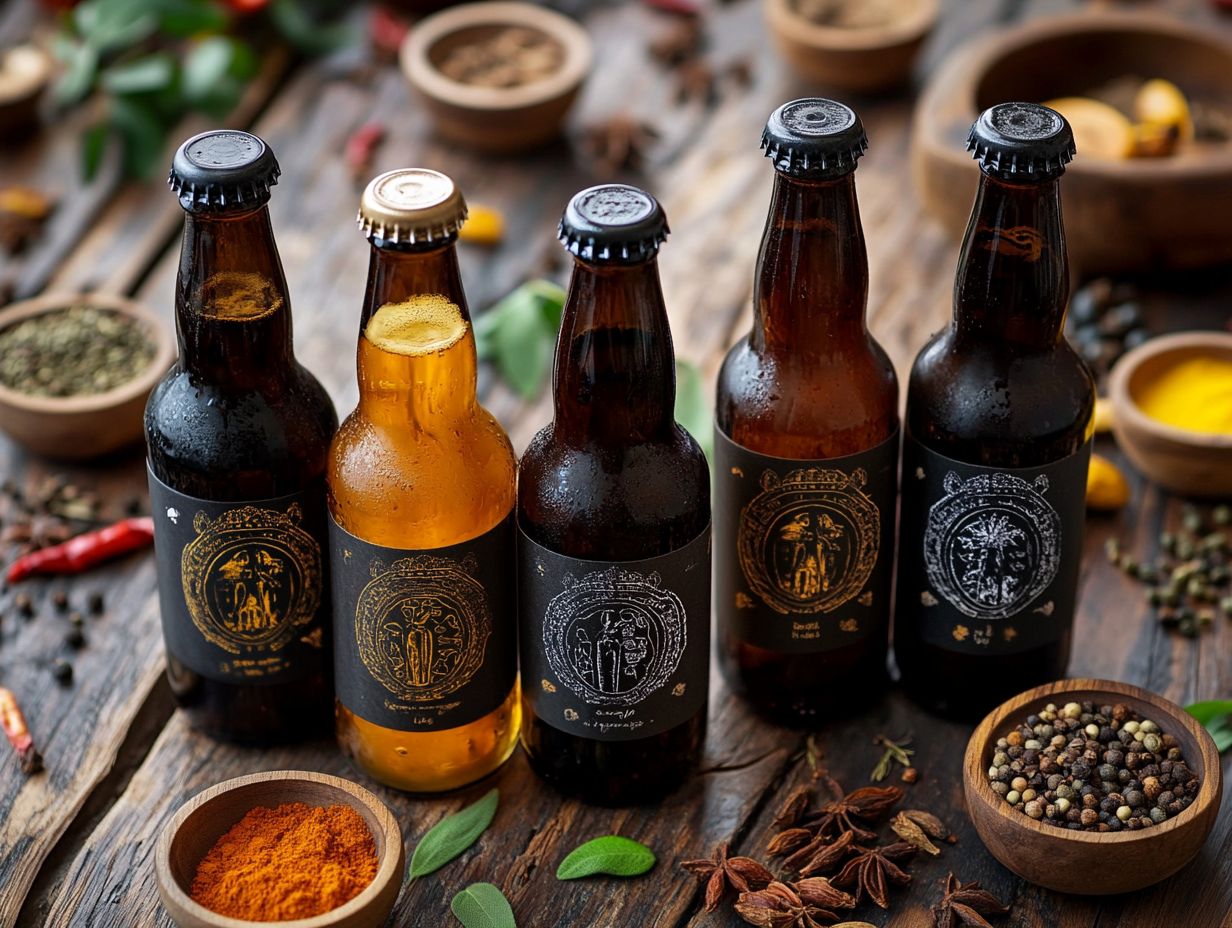
The incorporation of spices and herbs into beer is an art form. As a brewer, you can harness specific ingredients to create distinctive flavor profiles that captivate the palate. Spices like coriander and herbs such as lavender or chamomile can add unique twists to traditional brews.
This delicate craftsmanship often involves introducing spices and herbs at various stages of brewing. You might add them during the boil, fermentation, or even after kegging, depending on the intended aroma and depth of flavor. Techniques like using pasteurizers help maintain the desired flavor profile.
For example, you might choose to add coriander and orange peel early in the boil of a Belgian-style witbier. This infuses the beer with subtle citrus notes for a refreshingly vibrant profile. Conversely, consider a stout brewed with vanilla beans introduced during fermentation. This yields a luscious, dessert-like quality that beautifully showcases the interplay of ingredients.
These methods not only enhance your individual offerings but also invite drinkers into an exquisite experience. They encourage exploration and appreciation of the unique flavors your craft has to offer.
What Makes Sour Beers Different from Traditional Beers?
Sour beers stand apart from traditional varieties primarily through the way beer is made. They embrace wild yeast strains like Brettanomyces and bacteria such as Lactobacillus and Pediococcus, which create a distinct tartness and complexity in flavor profiles.
What truly distinguishes these beverages is the use of open fermentation vessels. This method invites wild yeast and bacteria to mingle with the environment, enabling a more spontaneous fermentation. Many brewers also use techniques like kettle souring, where the wort is intentionally soured before boiling, to amplify acidity.
By incorporating unconventional ingredients like fruits, spices, herbs, or specialty grains such as berries, pumpkins, and peppers, sour beers complement tartness and introduce layers of depth to the flavor.
This intricate interplay of techniques and ingredients creates a unique taste journey in each batch of sour beer. It diverges significantly from the cleaner profiles typically found in traditional beer styles.
What Types of Barrels Are Used for Aging Beer?
The choice of barrels for aging beer is essential for crafting unique flavors. Options like whiskey, wine, and rum barrels provide distinct characteristics that can enhance the final product significantly. Breweries like Rogue Ales and Wynkoop Brewing Company have perfected the art of barrel-aging, infusing their beers with complex flavors.
Take, for example, Goose Island’s Bourbon County brand. They utilize freshly emptied bourbon barrels, infusing their stouts with rich caramel and vanilla notes that truly stand out.
On the other hand, craft producers like Sierra Nevada embrace wine barrels, allowing their beers to soak up fruity complexities and tannins that add depth. Some breweries even opt for rum barrels, lending a delightful tropical sweetness and transforming traditional styles into innovative creations. Innovative breweries like Bruggh s Ste ja and Mikkeller are known for their unique barrel-aging techniques.
Craft brewers are boldly venturing into exciting new flavor dimensions by thoughtfully selecting and repurposing barrels. They illustrate that the aging process is not simply a preservation technique but rather an art form, elevating beer to extraordinary heights.
How Are Smoked Beers Made and What Gives Them Their Distinct Flavor?
The production of smoked beers is a meticulous process involving smoking barley and alternative grains over wood. This method provides a distinct flavor that sets smoked beers apart from traditional options. Craft breweries like the Pizza Beer Company have taken these beers to new heights with innovative flavors.
Craft breweries are constantly redefining beer making by experimenting with various smoking techniques, including hot and cold smoking, to enhance flavor complexity. Depending on the type of wood they choose be it hickory, cherry, or oak the flavor profile can range from sweet and fruity to deep and earthy. Each wood type adds its own unique character, giving brewers the freedom to tailor their creations.
For example, cherry wood may impart a subtle sweetness, while oak offers a robust, toasty essence. These innovative techniques challenge conventional brewing methods and delight beer enthusiasts with layered flavors, creating a truly unique sensory experience.
Frequently Asked Questions
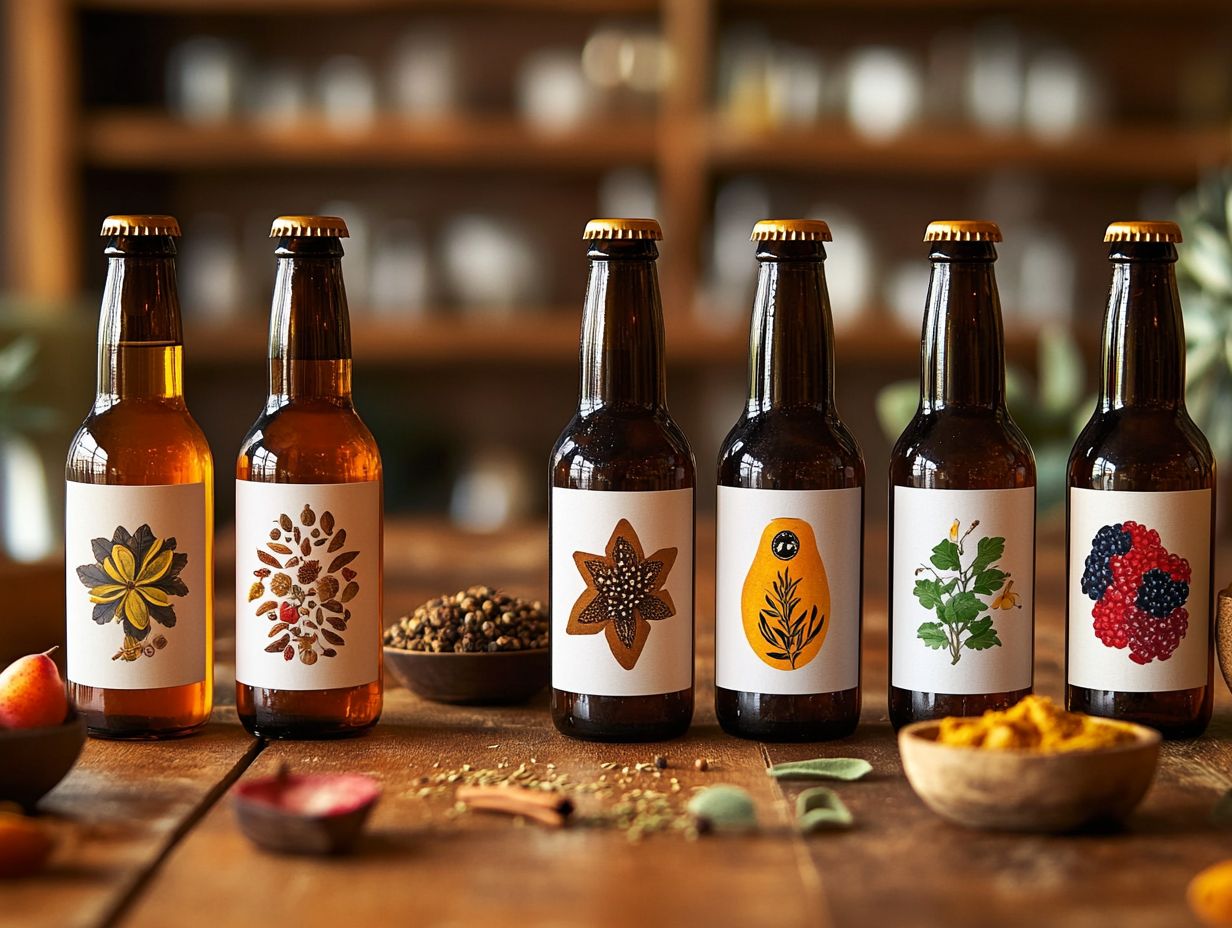
What are the top 5 craft beer styles with unique ingredients?
The top 5 craft beer styles with distinct ingredients are Belgian Witbier, German Rauchbier, American IPA, Scottish Ale, and Mexican-style Lager.
What makes Belgian Witbier a unique craft beer style?
Belgian Witbier is brewed with wheat, coriander, and orange peel, giving it a zesty, citrusy flavor. This combination enhances its taste and highlights its cultural significance.
What makes German Rauchbier stand out from other craft beer styles?
German Rauchbier is distinct because it is brewed with smoked malt, resulting in a smoky, campfire-like flavor and aroma. This beer style often employs historical methods, emphasizing the value of smoked grains.
Why is American IPA considered a craft beer with unique ingredients?
American IPA is known for its use of special hops, such as Citra, Simcoe, and Amarillo, which create a strong, bitter, and fruity flavor. Breweries like Edward A. Michalski have pioneered the innovative use of hops in this style.
What sets Scottish Ale apart from other craft beer styles?
Scottish Ale is brewed with roasted barley, giving it a dark color and a malty, caramel flavor. The brewing process often includes traditional techniques passed down through generations.
Why is Mexican-style Lager a must-try for craft beer enthusiasts?
Mexican-style Lager is made with corn and often incorporates local ingredients, such as agave, resulting in a light, refreshing taste that pairs perfectly with Mexican cuisine. This creativity showcases the innovation within the craft beer scene.

